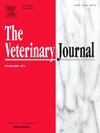Evaluation of some cardiac biomarkers in cats with primary and secondary cardiomyopathies
IF 3.1
2区 农林科学
Q1 VETERINARY SCIENCES
引用次数: 0
Abstract
Cardiomyopathies (CMs) are one of the most predominant disorders in cats. Cardiac biomarkers can offer an economical alternative for the initial diagnosis of CM in comparison to the more costly echocardiography. This study aimed to assess the diagnostic accuracy of cardiac troponin I (cTnI), creatine kinase MB (CK-MB), N-terminal pro-brain natriuretic peptide (NT-proBNP), mid-regional pro-adrenomedullin (MR-proADM), and galectin-3 (Gal-3) in detection of feline CMs. The study included 78 cats classified into 3 groups based on clinical examination, echocardiography, and analysis of serum cardiac biomarkers, renal function, and total thyroxine. Group I (apparently healthy cats, n = 16), group II (cats with primary CM, n = 37), and group III (cats with secondary CM, n = 25). Sensitivity, specificity, positive and negative predictive values, receiver operating characteristic curves were used to identify area under the curve and the corresponding cut-off value for each cardiac biomarker. Pearson’s correlation coefficient was also assessed. NT-proBNP, CK-MB, and Gal-3 were increased in groups II and III compared to group I. Meanwhile, cTnI was higher in group II than group III and MR-proADM was increased in group II only. NT-proBNP, cTnI, and CK-MB revealed moderate to strong positive correlations and the best diagnostic accuracy when compared to echocardiography, showcasing the benefits of multi-biomarker use. In conclusion, NT-proBNP, cTnI, CK-MB, and CK-RI exhibited the highest efficacy, and cTnI was able to statistically distinguish between primary and secondary CMs. In the absence of echocardiography, these biomarkers could be taken into account during the preliminary assessment for CM.
猫原发性和继发性心肌病的一些心脏生物标志物的评估。
心肌病(CMs)是猫最主要的疾病之一。与更昂贵的超声心动图相比,心脏生物标志物可以为CM的初步诊断提供经济的选择。本研究旨在评估心肌肌钙蛋白I (cTnI)、肌酸激酶MB (CK-MB)、n端脑利钠肽前体(NT-proBNP)、中部肾上腺髓质素前体(MR-proADM)和半乳糖凝集素-3 (Gal-3)检测猫CMs的诊断准确性。根据临床检查、超声心动图、血清心脏生物标志物、肾功能和总甲状腺素分析,将78只猫分为3组。第一组(明显健康的猫,n = 16),第二组(原发性CM猫,n = 37),第三组(继发性CM猫,n = 25)。采用敏感性、特异性、阳性预测值和阴性预测值、受试者工作特征曲线来确定每个心脏生物标志物的曲线下面积和相应的截止值。并评估Pearson相关系数。ⅱ组、ⅲ组NT-proBNP、CK-MB、Gal-3较ⅰ组升高,ⅱ组cTnI较ⅲ组升高,仅ⅱ组MR-proADM升高。与超声心动图相比,NT-proBNP、cTnI和CK-MB显示出中度至强烈的正相关和最佳的诊断准确性,显示了使用多种生物标志物的好处。综上所述,NT-proBNP、cTnI、CK-MB和CK-RI表现出最高的疗效,cTnI能够在统计学上区分原发性和继发性CMs。在没有超声心动图的情况下,这些生物标志物可以在CM的初步评估中考虑。
本文章由计算机程序翻译,如有差异,请以英文原文为准。
求助全文
约1分钟内获得全文
求助全文
来源期刊

Veterinary journal
农林科学-兽医学
CiteScore
4.10
自引率
4.50%
发文量
79
审稿时长
40 days
期刊介绍:
The Veterinary Journal (established 1875) publishes worldwide contributions on all aspects of veterinary science and its related subjects. It provides regular book reviews and a short communications section. The journal regularly commissions topical reviews and commentaries on features of major importance. Research areas include infectious diseases, applied biochemistry, parasitology, endocrinology, microbiology, immunology, pathology, pharmacology, physiology, molecular biology, immunogenetics, surgery, ophthalmology, dermatology and oncology.
 求助内容:
求助内容: 应助结果提醒方式:
应助结果提醒方式:


